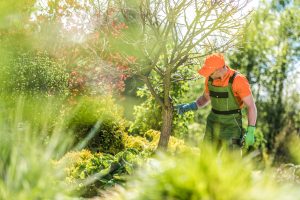Morton Arboretum offers info on trees with early fall color
By Ken Keenan For Chronicle Media — September 24, 2024
For people concerned about changes to trees in their own yard or neighborhood, there are signs and symptoms to monitor.
Trees are pretty tough. They can live for hundreds or even thousands of years, adapting to all kinds of weather conditions along the way.
However, those conditions can also have an impact on a tree’s behavior, especially during periods of extremely dry or unusually warm weather, a situation the Chicago area encountered for much of September.
With that in mind, The Morton Arboretum in Lisle, is providing scientific and practical information related to some trees in the area that are experiencing early fall color or brown leaves. A globally recognized leader in tree research and education, the Arboretum’s 1,700-acre site cares for nearly 107,000 specimens, representing more than 4,000 different types of trees and plants.
Arboretum Plant Clinic Manager Spencer Campbell said the three factors traditionally impacting fall color are dry winds, high temperatures and low soil moisture. Key among the three is the need for water.
“Water availability is essential,” Campbell said. “With the really dry weather, one rain event does not get down to the root system. Therefore, slow, steady soaks are important. Without a lot of moisture in the soil, that has an impact.”
Campbell said that adding dry winds and higher temps to the equation, “may result in leaf scorch,
 meaning the leaves lose water, and there isn’t enough water in the soil to compensate. If we get some rain in the next few weeks, the trees will be able to capture that resource. That will improve the tree’s ability to extract beautiful fall color.”
meaning the leaves lose water, and there isn’t enough water in the soil to compensate. If we get some rain in the next few weeks, the trees will be able to capture that resource. That will improve the tree’s ability to extract beautiful fall color.”
He added that seeing some early fall color isn’t necessarily concerning, noting that maple trees beginning to turn red is typical for mid-September.
“We do know that mid-October is the peak fall color time,” Campbell said. “But it’s not a light switch … more like a dimmer switch. You notice the changes slowly instead of all at once. It comes in waves instead.”
For people concerned about changes to trees in their own yard or neighborhood, Campbell said there are signs and symptoms to be aware of. He also provided some maintenance tips aimed at maintaining a tree’s health in general.
“No. 1, every newly planted tree needs water regularly — a slow and steady soak,” Campbell said. “Mature trees need that as well — once a week, about 30 minutes. If you notice your mature tree has decline in the canopy … early defoliation, or limb loss, or trunk wounds, or oozing on the trunk, those are signs to be aware of.
“The second step, if you notice something different, or a few things different, it’s time to think about calling a professional. The third and final step, if there is early fall color, we do not expect to see any impact next year. It’s all based on weather. During dry periods, water regularly — maybe twice a week. Again, it’s important to have water available in the soil, and sustain resources during winter so trees return strong and vibrant.”
Through its combined work, the Morton Arboretum’s Center for Tree Science, Global Tree Conservation Program, Chicago Region Trees Initiative and Center for Species Survival has a common goal: securing the future of trees — locally, nationally and worldwide — and contributing to a greener, healthier world where people and trees can thrive together.
“At The Arboretum, we have robust and scientific partners that care about the preservation of trees around the world,” Campbell said. “We are dedicated to sharing the information we gather with the public, and we want to help folks learn how to maintain trees in their neighborhood, and answer their questions. We’re trying to share the message: you should care about trees, starting with your own.”
For more information, visit www.mortonarb.org.







